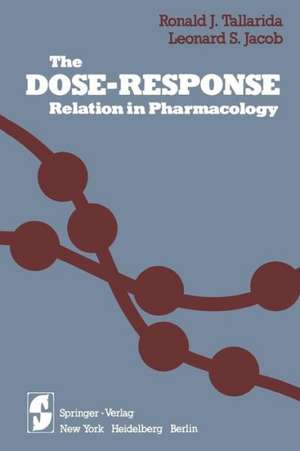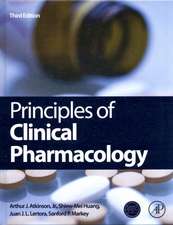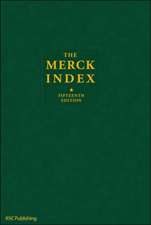The Dose—Response Relation in Pharmacology
Autor Ronald J. Tallarida, Leonard S. Jacoben Limba Engleză Paperback – 28 mar 2012
Preț: 364.74 lei
Preț vechi: 383.93 lei
-5% Nou
Puncte Express: 547
Preț estimativ în valută:
69.80€ • 72.11$ • 58.06£
69.80€ • 72.11$ • 58.06£
Carte tipărită la comandă
Livrare economică 20 martie-03 aprilie
Preluare comenzi: 021 569.72.76
Specificații
ISBN-13: 9781468462678
ISBN-10: 1468462679
Pagini: 224
Ilustrații: XIV, 210 p.
Dimensiuni: 155 x 235 x 12 mm
Greutate: 0.32 kg
Ediția:Softcover reprint of the original 1st ed. 1979
Editura: Springer
Colecția Springer
Locul publicării:New York, NY, United States
ISBN-10: 1468462679
Pagini: 224
Ilustrații: XIV, 210 p.
Dimensiuni: 155 x 235 x 12 mm
Greutate: 0.32 kg
Ediția:Softcover reprint of the original 1st ed. 1979
Editura: Springer
Colecția Springer
Locul publicării:New York, NY, United States
Public țintă
ResearchDescriere
This book is designed to meet the modern need for a better understanding of drug-receptor interaction as applied to the gathering and interpretation of dose-response data. It is an introduction suitable for any student who has had a first course in pharmacology. This book is an extension of the pharmacology course into one area of what is now known as molecular pharmacology. The material included is an outgrowth of courses that we have given in recent years to health-science students in several professional schools and universities. The area of drug-receptor theory, although just a part of molecular phar macology, is already very broad. One major line of investigation is concerned with the chemical and structural nature of specific receptors and with efforts to isolate specific receptors. Another line of investigation is concerned with the kinetic theories of drug-receptor interaction, the effort there being to provide a general theory that is applicable to wide classes of drugs. We have chosen to deal with the latter. There are several reasons for our choice of topics. First, the information is very practical; that is, it permits one to use properly and consistently terms such as "efficacy," "partial agonist," "pure antagonist," "potency," "pA2'" etc., when describing drug action. Second, many students fail to appreciate the differences in and the limitations of the various theories, beginning with the classical theory of A. J. Clark, on up to the very recent allosteric theories.
Cuprins
1. The Dose—Response Relation.- The Dose—Response Relation.- Methods of Plotting Dose-Response Curves.- Drug Antagonism.- Use of Dose-Response Curves.- Enhancement of Drug Action.- References.- 2. Functions and Relations.- Mathematical Symbols and Conventions.- Relations and Functions.- The Linear Function.- Equations in Linear Form: Scatchard and Lineweaver-Burk Plots.- Power Functions.- Exponential Functions: Half-Life.- Logarithms and Logarithmic Functions: The Henderson-Hasselbach Equation.- Rate of Change and Drug Action.- Integration.- References.- Additional Readings.- 3. Kinetics of Drug—Receptor Interaction: Interpreting Dose—Response Data.- Pharmacological Receptor.- Formation of the Drug-Receptor Complex.- Classical Theory.- Modification of Classical Theory.- Dissociation Constants of Competitive Antagonists.- Dissociation Constants of Agonists: Method of Partial Irreversible Blockade.- Dissociation Constants of Agonists: Method of Partial Agonists.- Perturbation Methods.- Allosteric Theory.- Rate Theory.- References.- 4. Construction of Dose—Response Curves: Statistical Considerations.- Mean Dose and Mean Response.- Mean and Standard Deviation.- Samples and Populations.- Distributions.- Normal Distribution.- Estimation.- Tests of Significance.- Linear Regression.- Parallel Lines—Assays and Antagonism.- Quantal Dose-Response Relation.- Probit Diagram.- References.- Additional Readings.- 5. Drug Binding and Drug Effect.- Receptor Interaction and Effect.- Binding Constants and Dissociation Constants.- Desensitization.- Molecularity and Order.- Pharmacokinetic Considerations.- In Vivo Considerations.- Protein Binding.- Receptor Status and Disease States.- References.- 6. Isolated Preparations: Dose-Response Data.- Rabbit Thoracic Aorta.- Guinea Pig Ileum.- Isolated Taenia Ceca.- Ductus Deferens Preparation of the Guinea Pig and Rat.- Rat Fundus Strip.- Phrenic Nerve Diaphragm Preparation of the Rat.- Rat Uterus Preparation.- Frog Rectus Abdominus.- Isolated Rabbit Heart.- References.- Appendix A. Mathematical Tables.- Appendix B. Molecular Weights of Selected Drugs and Composition of Solutions.- Appendix C. Calculus.








